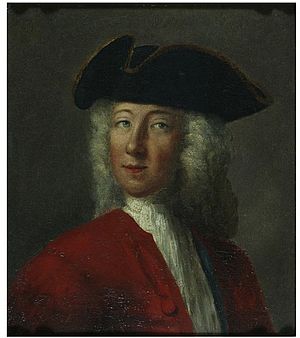Henry Hare, 3rd Baron Coleraine facts for kids
Quick facts for kids
The Lord Coleraine
|
|
|---|---|
 |
|
| Born | 10 May 1693 Betchworth, Surrey
|
| Died | 1 August 1749 (aged 56) |
| Nationality | British |
| Alma mater | Corpus Christi College, Oxford |
| Known for | Fellow of the Royal Society; Fellow of the Society Antiquaries |
| Parent(s) |
|
Henry Hare, 3rd Baron Coleraine (born May 10, 1693 – died August 1, 1749) was an important English nobleman and politician. He was also a keen historian and collector of old things, known as an antiquary. He held a seat in the House of Commons, which is like a part of the British Parliament.
Contents
Early Life and Education
Henry Hare was born in Betchworth, Surrey, on May 10, 1693. He was the oldest son of Hugh Hare and Lydia Carlton. He went to school in Enfield.
When his grandfather, Henry Hare, 2nd Baron Coleraine, passed away in 1708, Henry inherited the title of Baron Coleraine. This made him a peer, a member of the nobility. He later attended Corpus Christi College, Oxford when he was 17 years old.
A Love for History and Art
Henry Hare loved to travel and explore. He visited Italy three times. During one trip around 1723, he collected many prints and drawings. These showed old buildings, art, and historical sites in Italy. After he died, this collection was given to Corpus Christi College.
He was part of a group of writers and thinkers called the Republica Letteraria di Arcadia. He was also good friends with Marquis Scipio Maffei, a famous Italian historian. They often met at Henry's home, Bruce Castle, in Tottenham.
Henry was very interested in history. He became a Fellow of the Society of Antiquaries in 1725. This society studies ancient things and history. He often served as a vice-president for the group. He also joined other historical societies. In 1728, he became the Grand Master of Freemasons, a well-known social organization. In 1730, he was chosen as a Fellow of the Royal Society, which is a very old and respected group for scientists.
Henry also supported artists. He helped George Vertue, a famous engraver, by taking him on tours to draw historical sites in England.
A Role in Politics
In 1730, Henry Hare was elected as a Member of Parliament for Boston, Lincolnshire. He was a member of the Tory party. As an MP, he voted against the government's plans on several occasions. For example, he voted against increasing the army in 1732. He also opposed the Excise Bill in 1733, which was a tax on certain goods.
In 1734, he spoke against allowing the King to increase military forces during a break from Parliament. He decided not to run for re-election in the 1734 general election.
His Legacy
Henry Hare left many of his drawings and prints of old British buildings to the Society of Antiquaries. However, there was a legal issue with his will. Even so, his friend Rose Duplessis made sure the society received them. She also gave them a portrait of Henry when he was younger.
His large library of books was sold in 1754. Many private papers and historical documents were found hidden behind the bookshelves. Among these was a handwritten history of Tottenham by his grandfather. His art and antique collections were also sold.
His Family
Henry Hare married Anne Hanger in 1718. Anne was the daughter of John Hanger, who was the Governor of the Bank of England. She brought a large sum of money to the marriage. However, the couple separated in 1720 and had no children together.
Later, Henry had a daughter named Henrietta Rosa Peregrina, born in Italy in 1745. Since he had no children with his wife, Henry wanted to leave his Tottenham estates to Henrietta. However, because she was not born in England, the land legally went to the Crown. Later, a special permission was given for the land to go to James Townsend, whom Henrietta married in 1763.
Henry's wife, Lady Coleraine, lived until 1754. Henry Hare passed away in August 1749 and was buried in Tottenham.

